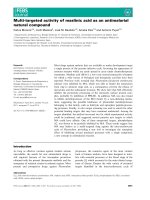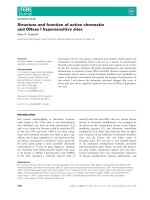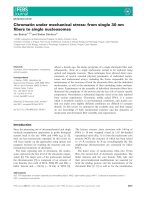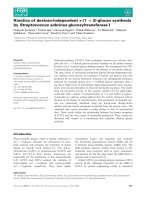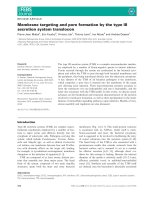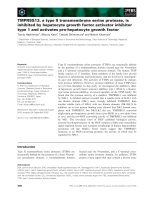Báo cáo khoa học: Symposia Lectures pdf
Bạn đang xem bản rút gọn của tài liệu. Xem và tải ngay bản đầy đủ của tài liệu tại đây (266.29 KB, 13 trang )
Monday, July 9, 2007
A2-L1
J. Diffley
No abstract available.
A2-L2
Molecular bioimaging of gene transcription
P. Cramer
Gene Center, Munich, GERMANY
In the first half of the talk, the current state of our ongoing structure-function analysis of the mRNA transcription cycle will be dis-
cussed. The crystallographic structures of the complete 12-subunit RNA polymerase II in free form and with bound DNA and RNA
have been determined as atomic models. The structure of the complete Pol II elongation complex bound by the transcript cleavage factor
TFIIS explained how Pol II uses a single tunable active site for both RNA synthesis and RNA cleavage. Three structures of complexes
of CTD-interacting proteins provided insights into the coupling of transcription elongation to mRNA processing and histone methyla-
tion, and into Pol II recycling. The first structure of a Pol II complex with an RNA inhibitor and the first atomic structures of subcom-
plexes of the mediator of transcriptional regulation provided insights into gene regulation. In the second half of the talk, recently
published and unpublished data will be presented that will show the directions for future investigations. A set of new structures of Pol II
bound to damaged DNA together with complementary functional assays revealed an unexpected mechanism of lesion recognition during
transcription-coupled DNA repair. Soon we will obtain new insights into the structure and function of the distantly related RNA polym-
erase I, which produces ribosomal RNA. This part of the talk will highlight the complementary use of various structural (X-ray, EM,
NMR) techniques and functional studies in vitro and in vivo.
Symposia Lectures Monday
18
A2-L3
Unified mode of centromeric protection by shugoshin in mammalian oocytes and somatic cells
Y. Watanabe
University of Tokyo, Tokyo, JAPAN
Centromeric protection of cohesin from separase-cleavage at meiosis I is a hallmark of reductional chromosome segregation, an essential
step to reduce ploidy, and potentially related to human birth defects. We here demonstrate that mammalian shugoshin protein Sgo2 is
responsible for this protection in oocytes. However, Sgo2 also protects cohesin in mitosis from the so-called prophase pathway, but
never at the onset of anaphase of mitosis as well as meiosis-II in spite of its localization at centromeres. We found that Sgo2 colocalizes
with cohesin at the inner centromere in mitotic prophase and meiosis-I (where centromeres are mono-oriented and not under tension),
but they come apart during mitosis and meiosis-II, depending on tension across bi-oriented centromeres. Accordingly, we demonstrate
that the tension on mitotic chromosomes displaces shugoshin within centromeres and de-protects cohesin, since cohesin can be dissoci-
ated from centromeres at metaphase arrest even prior to onset of anaphase. Our study thus solves the puzzle of why the same shugoshin
molecule can protect cohesin at anaphase onset of meiosis-I but neither of meiosis-II nor mitosis, providing insight into the evolution of
centromeric protection for meiotic chromosome segregation.
A2-L4
RNAi and gene silencing in heterochromatin
D. Moazed
Harvard Medical School, BOSTON, MA, USA
Assembly of heterochromatin at the fission yeast centromeres requires components of the RNAi machinery as well as histone binding
proteins and modifying enzymes. We have identified several multiprotein complexes that link the RNAi pathway to heterochromatin
assembly, and have analyzed their activities in vitro and in vivo. Our results suggest that RNAi complexes associate with nascent RNA
transcripts to initiate and maintain gene silencing. The mechanism of silencing involves the co- transcriptional degradation of RNAs that
are transcribed in heterochromatic domains. We refer to this novel silencing mechanism as CTGS (Co-Transcriptional Gene Silencing).
Monday Symposia Lectures
19
A2-L5
M. Matzke
GMI, Vienna, AUSTRIA
No abstract available.
B2-L1
Assembly and operation of the Yersinia injectisome
G. R. Cornelis
Biozentrum, Basel, SWITZERLAND
The type III secretion injectisome is a nanosyringe that injects bacterial effector proteins into the cytosol of eukaryotic cells. It is related
to the flagellum, with which it shares structural and functional similarities. It consists of a basal body made of several rings spanning the
bacterial membranes, connected by a central tube. On top of the basal body, comes a short stiff needle. The basal body contains the
export apparatus, which serves first for the export of the needle subunits and later for effectors. This structure is sufficient for exporting
effector proteins across the two bacterial membranes but not to inject them into the cytosol of target cells. This translocation step
requires three more proteins, LcrV, YopB and YopD, in the case of Yersinia. LcrV forms a structure at the tip of the needle and this
structure is believed to act as a scaffold for the insertion of a pore made of YopB and YopD into the target cell membrane. LcrV is
known since the mid nineteen fifties to be a protective antigen against plague. The length of the needle is controlled by a mechanism
involving a protein thought to act both as a molecular ruler and a substrate specificity switch. When assembly of the needle is complete,
the molecular ruler changes the substrate specificity of the export apparatus, which becomes ready to export pore formers and the effec-
tors. Export of the latter will only occur upon contact with a target cell.
Symposia Lectures Monday
20
B2-L2
Structure, assembly and function of the Salmonella type III protein secretion nanomachine
J. E. Galan
Yale University School of Medicine, New Haven, CT, USA
A central component of type III secretion systems is a multi-protein organelle known as the needle complex. This organelle is composed
of a multi-ring based anchored to the bacterial envelope, an inner rod embedded within the base, and a slender extension or needle that
protrudes from the bacterial surface. Assembly of the needle complex occurs through a series of discrete and well-coordinated steps
resulting the assembly of the base substructure. This substructure operates as a ‘type III secretion machine’ but exclusively dedicated to
the export of the components of the inner rod and needle substructures. Upon completion of the assembly of the entire needle complex,
the type III secretion machine switches substrate specificity becoming competent for the secretion of effector proteins. The details of the
type III secretion organelle assembly process and its function will be discussed.
References
1. Kubori T, Matsushima Y, Nakamura D, Uralil J, Lara-Tejero M, Sukhan A, Galan JE, Aizawa S I. Science 1998; 280: 602–605.
2. Kubori TK, Sukhan A, Aizawa S I Galan JE. Proc. Natl. Ac. Sci. USA 2000; 97: 10225–10230.
3. Marlovitz TC, Kubori T, Sukhan A, Thomas DR, Galan JE, Unger UM. Science 2004; 306: 1040–1042.
4. Akeda Y, Galan JE. Nature 2005; 437: 911–5.
5. Marlovitz TC, Kubori, T., Lara-Tejero, M., Thomas, D. R., Unger, V. M., and J. E. Galan. 2006. Nature 441(7093):637–40.
6. Galan JE, Wolf-Watz H. Nature. 2006; 444(7119): 567–73.
B2-L3
mRNA localization and polarized growth in yeast
J. E. Gerst, R. Gelin-Licht, L. Haim, L. Yakir-Tamang and G. Zipor
Weizmann Institute of Science, Rehovot, ISRAEL
Targeted mRNA trafficking may play a pivotal role in determining the local concentration of protein and, thus, influence a number of
cellular processes, such as polarization, division, and body morphogenesis. By using the yeast Saccharomyces cerevisiae, we demonstrated
that mRNAs encoding polarity and secretion factors (POLs; i.e. Sro7, Cdc42, Sec4) involved in polarity establishment and polarized
growth are trafficked to the presumptive bud site and localize to the bud tip during division. As POL mRNA trafficking precedes POL
protein enrichment and budding, it suggests that mRNA transport facilitates polarized growth. Furthermore, asymmetric mRNA traf-
ficking is directly connected with the transport of cortical ER (Aronov et al. Mol. Cell. Biol. 2007; 27: 3441–55). These axioms also hold
true for haploid cells treated with mating factor, which develop polarized membrane extensions (shmoos) analogous to neural or podial
projections in higher organisms. However, in contrast to budding yeast, two mRNA trafficking mechanisms – one SHE-dependent and
the other SHE-independent – operate during shmooing. Other work demonstrates that non-polarized mRNAs, such as those encoding
peroxisomal and mitochondrial proteins, are also targeted to specific subcellular destinations. Thus, all mRNAs have a specific pattern
of distribution and we are developing novel techniques to localize endogenous mRNAs in vivo (Haim et al. Nat. 2007 Methods, pub.
online).
Monday Symposia Lectures
21
B2-L4
Genome-wide quantitative image analysis of endocytosis and signalling
C. Collinet, Y. Kalaidzidis and M. Zerial
Max Planck Institute of Molecular Cell Biology and Genetics MPI-CBG, Dresden, GERMANY
Endocytosis is an essential process serving multiple key cellular functions, such as nutrient uptake, signal transduction, and defence
against pathogens. Small GTPases of the Rab family act as membrane organizers, specifying the structural and functional identity of
endosomes. Various Rab GTPases occupy distinct membrane domains on early endosomes (Rab5, Rab4 and Rab11) or late endosomes
(Rab7 and Rab9), termed ‘Rab-domains’. Rab-domains are dynamically assembled and disassembled on the membrane, as in the case of
the Rab5-domain which is disassembled and replaced with Rab7 in the course of transport from early to late endosomes. To identify
other components of the endocytic apparatus we performed high-content image-based genome-wide RNAi screening in human cells. The
genes were identified on the basis of a multi-parametric analysis comprising ~40 parameters such as endosome size, intracellular distribu-
tion and concentrations of labeled proteins, and a set of statistical procedures. Selected genes were subjected to an in-depth analysis,
using fast live cell imaging and novel image analysis algorithms, including particle detection and tracking algorithms. This multi-para-
metric analytical platform is used to develop a mathematical model that can quantitatively predict endosome dynamics and signalling
properties under various physiological and pathological conditions.
B2-L5
Alternative paths to lysosomes
H. Stenmark
The Norwegian Radium Hospital, Oslo, NORWAY
Proteasomes and lysosomes are the major sites for protein degradation in the cell. Whereas lysine-48-linked polyubiquitin chains target
cytosolic substrate proteins for proteasomal degradation, monoubiquitin, often attached at multiple target lysines, is frequently used as a
signal for lysosomal degradation of membrane proteins. A special case of lysosomal protein degradation involves autophagy, the seques-
tration of portions of cytoplasm by a double-membraned structure called the autophagosome. When the autophagosome fuses with a
lysosome, the sequestered material will be degraded. We have been studying lysosomal protein transport in two contexts: Lysosomal
trafficking of endocytosed growth factor receptors as a mechanism of ligand-mediated receptor downregulation, and autophagy of cyto-
plasmic ubiquitin-positive protein aggregates as a mechanism of neuroprotection. Central in these processes are complexes of ubiquitin-
binding proteins that mediate lysosomal sorting. We are now elucidating the structures and functions of these sorting complexes.
Symposia Lectures Monday
22
C2-L1
Road to ruin: apoptotic pathways in the nematode C. elegans
M. Hengartner
University of Zu
¨
rich, Zu
¨
rich, SWITZERLAND
No abstract available.
C2-L2
Protease signalling: cysteine cathepsins pathways to cell death
B. Turk
J. Stefan Institute, Ljubljana, SLOVENIA
Apoptosis is the major way of eliminating potentially harmfull and superfluous cells. The pathway is severely impaired in cancer and
cancer cells generally fail to die. Proteolysis plays an essential role in the process with caspases being the major players. However, there
is increasing evidence that lysosomal proteases are actively involved in apoptosis. Among them the most abundant and best characterized
are cysteine cathepsins, including cathepsins B and L, and the aspartic protease cathepsin D. A critical point is lysosomal membrane per-
meabilization (LMP), which leads to translocation of lysosomal proteases to cytosol. Despite considerable evidence, the signaling path-
ways downstream of LMP are not well understood. In order to study these mechanisms, we have been using a model system using the
lysosomotropic compound LeuLeu-OMe, which was shown to significantly reduce the graft-versus-host disease in a mouse model. We
were able to show in eight cellular models that selective lysosome disruption with Leu-Leu-OMe resulted in apoptosis, characterized by
lysosome disruption, translocation of lysosomal proteases to the cytosol and subsequent activation of caspases indirectly through mito-
chondria disruption. The proapoptotic Bcl-2 family member Bid was found to be a cellular target for cysteine cathepsins in most cells
used. In addition to Bid, some other cathepsin cellular targets were also identified and will be further discussed, as well as the pathways
in the absence of caspase activity.
Monday Symposia Lectures
23
C2-L3
Functional characterization of the cylindromatosis tumor suppressor
G. Mosialos
1,2
, E. Trompouki
2
, A. Tsagaratou
2
and D. Kontoyiannis
2
1
Aristotle University of Thessaloniki, Thessaloniki, GREECE,
2
BSRC Al. Fleming, Vari, GREECE
The cylindromatosis tumor suppressor gene (cyld) has been associated with the development of various pathologies. Mutations in cyld
predispose humans to the development of tumors of skin appendages and cyld downregulation has been linked to inflammatory disor-
ders and cancer of the colon and liver. Cyld encodes a 956 amino acid cytoplasmic protein (CYLD) which has deubiquitinating activity
that targets preferentially lysine-63-linked polyubiquitin chains. CYLD is a negative regulator of NF-kappaB and JNK activation by
members of the tumor necrosis factor receptor superfamily. The deubiquitinating activity of CYLD has been linked genetically to its
NF-kappaB inhibitory and tumor suppressing activities. In order to characterize the function of CYLD in vivo we have generated mice
with targeted inactivation of the catalytic domain of CYLD in a conditional format. Interestingly, mice with inactivated CYLD in all tis-
sues ( cyld
–/–
) died shortly after birth, from apparent respiratory failure. No major developmental defects were noted. Histological exam-
ination of lung tissue from E18.5 embryos revealed a higher overall density with abnormal alveolar epithelia and septa in samples from
cyld
–/–
embryos compared to samples from wild type embryos. Tissue specific inactivation of CYLD in thymocytes and macrophages
revealed an essential role for CYLD in thymocyte positive selection and macrophage response to inflammatory stimuli. Our experiments
have revealed a pleiotropic function of CYLD in mammalian physiology. The molecular mechanisms that underlie the phenotypic char-
acteristics of CYLD inactivation will be discussed.
C2-L4
Genetic analysis of the mammalian cell cycle: Cdk1 is sufficient to drive mammalian cell division
M. Barbacid
Centro Nacional de Investigaciones Oncologicas (CNIO), Madrid, SPAIN
We and others have shown that none of the four kinases implicated in driving interphase during the mammalian cell cycle, Cdk2, Cdk3,
Cdk4 and Cdk6, are essential for cell division. Likewise, we have reported that most cells proliferate well in the absence of Cdk4 and
Cdk6, Cdk6 and Cdk2 (Malumbres et al., Cell 2004; 118: 493) and more recently, in the absence of Cdk4 and Cdk2 (Barrier et al. Mol.
Oncology, in press). We have now generated embryos lacking all interphase Cdks. Triple knock out Cdk4(-/-);Cdk6(-/-);Cdk2(-/-)
embryos (Cdk3 is not functional due to a natural mutation) develop until midgestation and display normal levels of cell proliferation
and organogenesis. As expected, they do not survive to term due to lack of proliferation of hematopoietic cells, a defect attributed to
the absence of Cdk4 and Cdk6. This defect appears to be somewhat exacerbated by the absence of Cdk2. Cdk4(-/-); Cdk6(-/-); Cdk2(-/-)
MEFs proliferate in culture and become immortal upon serial passage. However, these cells display an extended interphase and prolifer-
ate more slowly than wild type MEFs or MEFs expressing just one interphase Cdks. pRb is phosphorylated at well known sites in these
triple knock out cells. Thus, mammalian cells can divide with just Cdk1. Ablation of Cdk1, however, prevents cell division. These obser-
vations, taken together, indicate that ‘interphase Cdks’ are required to ensure proliferation of specific cell types but are not essential to
drive the basic mammalian cell cycle as previously thought.
Symposia Lectures Monday
24
C2-L5
Distinct mechanisms of tumor invasion and metastasis
G. Christofori
Institute of Biochemistry and Genetics, Basel, SWITZERLAND
Tumor cell invasion into the surrounding tissue can exhibit a phenotype of either single cell or collective cell migration. Single cell migra-
tion is mainly dependent on signaling pathways within migrating cells themselves and is usually accompanied by an epithelial-mesenchy-
mal transition (EMT), which involves several genetic and epigenetic alterations including the loss of E-cadherin and the gain of
N-cadherin expression (the cadherin switch). Gene expression profiling experiments together with biochemical analysis reveal that the dis-
tinct stages of EMT are tightly regulated by epistatic cascades of transcriptional control circuits which involve activation and repression
of a large number of genes modulating the migratory and invasive behavior of tumor cells. In contrast, collective cell migration requires
the maintenance of cell-cell adhesion and a certain multicellular organization of the tumor tissue. Recently, we have shown that the
expression of podoplanin, a small mucin-like protein, is upregulated in a number of human carcinomas, in particular squamous cell car-
cinomas. Podoplanin induces tumor cell spreading, migration and invasion in vitro and in vivo by a novel molecular pathway of collec-
tive invasion that does not involve the loss of E-cadherin function or EMT.Finally, we propose a third type of metastatic tumor cell
dissemination which involves an upregulated expression of lymphangiogenic factors, such as vascular endothelial growth factors C and
D, and the subsequent induction of lymphangiogenesis. Increased lymphatic vessel density within and around expanding tumors leads to
lymph node metastasis, most likely by a passive washing out and trapping of tumor cell clusters in regional lymph nodes.
D2-L1
The crucial role of mitochondria in iron-sulfur protein biogenesis and cellular iron metabolism
R. Lill
Zytobiologie, Marburg, GERMANY
Research over the past few years has established the crucial role of mitochondria in both the biogenesis of iron-sulfur (Fe/S) proteins
and the regulation of cellular iron homeostasis. The two processes are coupled mechanistically in that defects in Fe/S protein biogenesis
elicit increases in both cellular and mitochondrial iron import. The molecular basis of Fe/S cluster synthesis and assembly into apopro-
teins in a living cell has been subject to intense research activities (see Review). Biogenesis is accomplished by three complex proteina-
ceous machineries. Mitochondrial Fe/S proteins require the iron-sulfur cluster (ISC) assembly machinery which was inherited from
bacteria during evolution. Cytosolic/nuclear Fe/S protein assembly also requires the function of this machinery, yet additionally depends
on the mitochondrial ISC export apparatus and the cytosolic iron-sulfur protein assembly (CIA) machinery. The components of all three
systems are highly conserved in eukaryotes from yeast to man suggesting similar mechanisms of Fe/S protein assembly. We are currently
most interested in defining the molecular basis of the contribution of mitochondria for cytosolic/nuclear Fe/S protein biogenesis. The
process is of importance for human disease. Depletion of frataxin leads to the neurodegenerative disease Friedreich’s ataxia, and a defect
in ABCB7 is associated with X-linked sideroblastic anemia and ataxia (XLSA/A).
Reference
1. Lill R, Mu
¨
hlenhoff U. Iron-sulfur protein biogenesis in eukaryotes: components and mechanisms. Annu Rev Cell Dev Biol 22, 457–486.
Monday Symposia Lectures
25
D2-L2
Cytochrome c binding to the cytochrome bc1 complex: an interaction critical for electron transfer
S. Solmaz, T. Wenz, U. Scha
¨
fer, A. Nyola and C. Hunte
Max-Planck-Institute of Biophysics, Frankfurt am Main, GERMANY
Small diffusible redox proteins facilitate electron transfer in respiration and photosynthesis by alternately binding to integral membrane
proteins. Structural information about specific and transient complex formation is scarce. In cellular respiration, the mobile electron carrier
cytochrome c shuttles electrons from the cytochrome bc1 complex to cytochrome c oxidase. The x-ray structure of the complex between
cytochrome c and cytochrome bc1 complex at 2.97-A
˚
resolution gave first structural insight for such a complex from the respiratory
chain [Lange and Hunte, Proc. Natl. Acad. Sci. USA 2002]. The structure revealed the nature of the interface, which is clearly well suited
for transient interaction and fast turnover. The close spatial arrangement of the cofactors suggests a direct heme-to-heme electron trans-
fer. Remarkably, cytochrome c binds to only one recognition site of the homodimeric complex. We now determined the structure of the
electron transfer complex in the reduced state at 1.9 A
˚
resolution [Solmaz and Hunte, in prep]. The high resolution allows an accurate
description of the interface, focussing especially on the role of the electrostatic and water-mediated interactions. Comparison with a sec-
ond structure obtained for the isoform-2 of cytochrome c bound to the cytochrome bc1 complex lead to the definition of a minimal
interface, the core interface, which is present in all of these structures. The importance of single residues of the core interface has been
challenged by site-directed mutagenesis and characterization of the variants in respect to complex formation and electron transfer. This
work is also of general interest for the area of weakly associated protein complexes.
D2-L3
Dynamics of the photosynthetic membrane during acclimation to a changing light environment
J. Rochaix
University of Geneva, Geneva, SWITZERLAND
Photosynthetic organisms are able to adjust to changes in light quality and to maintain a high photosynthetic yield through state transi-
tions. This process leads to a balancing of the light excitation energy between the light harvesting systems (LHC) of photosystem II
(PSII) and photosystem I (PSI). Preferential stimulation of PSII relative to PSI leads to the reduction of the plastoquinone pool and to
the activation of a protein kinase which phosphorylates LHCII, a process which induces the displacement of LHCII from PSII to PSI
(state 2). Excess stimulation of PSI leads to the reverse process (state 1). We have used a genetic approach in Chlamydomonas with the
ultimate aim of identifying some of the key components involved in the signaling chain of state transitions. We have identified a chloro-
plast thylakoid-associated Ser-Thr protein kinase Stt7 which is required for the phosphorylation of LHCII and for state transitions. Stt7
interacts with LHCII, the cytochrome b6f complex and PSI, but not with PSII. Stt7 is related to the Stl1 kinase of Chlamydomonas and
to the protein kinases STN7 and STN8 of Arabidopsis. STN7 is also required for LHCII phosphorylation and state transitions and there
is some synergy between these two kinases. Comparison of this acclimation process in a green motile unicellular alga and a sessile land
plant has provided interesting insights into evolutionary aspects of this response.
Symposia Lectures Monday
26
D2-L4
Learning and innovation of multi-enzyme complexes: cooperation in a network context
P. Csermely
Semmelweis University, Budapest, HUNGARY
The network and game theory paradigms are increasingly used to describe the topology and dynamics of complex systems. Protein and
multi-enzyme complexes can be perceived as parts of large protein-protein interaction and metabolic networks with overlapping modules.
These networks are small-worlds, have a non-negligible amount of hubs, and contain long-range, low affinity contacts providing network
integrity and stability. Elements of these networks are in a dynamic contact with each other. Our recent results show that learning and
innovation are both needed to keep a satisfying level of cooperation in continuously changing, dynamic networks. The lecture will imply
these and other recent results of network topology and dynamics to the topological analysis of protein structures, protein complexes and
multi-enzyme complexes. As a part of this, we will show the role of hubs and central network elements in governing enzyme activity, al-
losteric regulation, protein motor function, signal transduction and protein stability. The importance of central network elements
enriched in active centers and ligand binding sites directing the dynamics of the entire protein will also be discussed. Stepping a level
higher, we will assess cooperation between members of protein and multi-enzyme complexes. Changes in network formation during stress
and ageing will also be introduced. Finally, we will discuss possible network-based strategies to expand the number of drug targets and
to overcome the current ‘target-shortage’ by introducing system-designed multi-target drugs.
D2-L5
Multistep catalysis by nanomachines
R. Perham
University of Cambridge, Cambridge, UK
Many biochemical transformations are multistep reactions and incapable of being catalysed by a single enzyme active site. Thus many
multistep transformations are catalysed by large assemblies of enzymes, which may have beautiful and elaborate quaternary structures
that contribute to the catalytic mechanism. In some instances, physical tunnels connect the active sites and allow intermediates to diffuse
between them; in other instances, prosthetic groups in the form of covalently attached swinging arms, such as lipoyl groups, biotinyl
groups and phosphopantetheine groups, serve to transfer the catalytic intermediates. These unusual structural features introduce aspects
of enzyme catalysis that go beyond what can be expected of individual uncomplexed enzymes; among them we can identify enhancement
of catalytic activity brought about by the retention of intermediates at high local concentrations, substrate channeling to negate compet-
ing side reactions, and the protection of catalytic intermediates from the degradation they might otherwise suffer in diffusing between
unconnected active sites. It is now apparent that molecular architecture and mechanical properties make crucial contributions over and
above the conventional chemistry at successive active sites, making it only proper to perceive such multifunctional enzymes as sophisti-
cated catalytic nanomachines.
Monday Symposia Lectures
27
E2-L1
Bacterial motility and its regulation by the chemosensory pathway
J. P. Armitage
University of Oxford, Oxford, UK
Most bacteria swim by rotating semi rigid helical flagellar filaments at 300 Hz, using membrane spanning ion driven rotary motors to
drive that rotation. The flagellum is the most complex multiprotein complex in a bacterial cell with coordinated gene expression and
assembly. The motor can switch rapidly between clockwise and counterclockwise rotation, and the switching frequency is regulated by a
histidine protein kinase dependent sensory pathway. Bacteria sense changes in their external environment via transmembrane chemore-
ceptors and the resulting change in the structure of the cytoplasmic domain of the receptors regulate the phosphorylation state of the
kinase, which in turn regulates the activity of a small protein that when phosphorylated binds the motor to induce switching. Signal ter-
mination and receptor adaptation are essential to allow future sensory responses. Escherichia coli has been shown to respond to a change
in a few molecules of an attractant over a background concentration of about five orders of magnitude. The sensitivity and gain of the
pathway, combined with an ease of phenotype measurement and data on all aspects of the pathway from kinetics to protein copy num-
ber, in vivo and in vitro have made this closed pathway one of the best studied in biology. The chemosensory kinase is responsible for
bringing the chemoreceptors together at the poles of the cell to form complex interacting networks of chemoreceptors, and these are
thought to allow for the sensitivity and gain of the system. I will outline the development of different modelling approaches to bacterial
chemotaxis, and how these are being adapted in the light of new data on the additional complexity identified in the chemosensory path-
ways of bacteria other than E.coli.
E2-L2
Multi-factorial disease and robustness: where Systems Biology makes a difference
H. Westerhoff
Manchester Centre for Interpretive Systems Biology, Manchester, UK, and Netherlands Institute for Systems Biology, Amsterdam,
THE NETHERLANDS
No abstract available.
Symposia Lectures Monday
28
E2-L3
Dynamic pathway modelling and cancer
U. Klingmu
¨
ller
German Cancer Research Center, Heidelberg, GERMANY
Cell growth and differentiation is determined by the regulated activation of signaling pathways that form complex intracellular signaling
networks. In many cancer cells signaling pathways are severely altered. A well-studied example is the JAK-STAT signaling cascade that
involves a latent transcription factor and mediates rapid signal transmission from cell surface receptors to the nucleus. To identify gen-
eral principles how these pathways influence cellular decisions and to predict targets for intervention we are combining quantitative data
generation with mathematical modeling. To examine the JAK1-STAT3 signaling pathway by a systems biology approach, we applied
quantitative immunoblotting to monitor the interleukin (IL)-6 induced activation of gp130, JAK1 and STAT3 in primary hepatocytes.
The time-resolved experimental data could only be fitted at sufficient quality by a mathematical model capturing the possibility that
STAT3 cycles between the nucleus and the cytoplasm. By data-based mathematical modeling we identify rapid nucleocytoplasmic cycling
as a conserved systems property of the JAK-STAT signaling cascade and successfully predict targets suitable for intervention. We are
currently applying this approach to other signaling pathways such the TGFbeta-mediated SMAD and the MAP kinase signaling cas-
cades.
E2-L4
Substrate competition as a source of ultrasensitivity in the inactivation of Wee1
J. E. Ferrell, Jr.
Stanford University School of Medicine, Stanford, CA, USA
The mitotic regulators Wee1 and Cdk1 can inactivate each other through inhibitory phosphorylations. This double-negative feedback
loop is part of a bistable trigger that makes the transition into mitosis abrupt and decisive. To generate a bistable response, some
component of a double-negative feedback loop must exhibit an ultrasensitive response to its upstream regulator. Here we experiment-
ally demonstrate that Wee1 exhibits a highly ultrasensitive response to Cdk. Several mechanisms can, in principle, give rise to ultra-
sensitivity, including zero-order effects, multisite phosphorylation, and competition mechanisms. We found that the ultrasensitivity in
the inactivation of Wee1 arises mainly through two competition mechanisms: competition between two sets of phosphorylation sites
in Wee1 and between Wee1 and other high affinity Cdk1 targets. Based on these findings, we were able to reconstitute a highly ultra-
sensitive Wee1 response with purified components. Competition provides a simple way of generating the equivalent of a highly
cooperative allosteric response.
Monday Symposia Lectures
29
E2-L5
Deducing the unseen: the hidden side of systems biology
J. Stark
Imperial College London, London, UK
Modern high throughput experimental techniques are generating increasingly large and complex data sets. There is growing agreement
that to fully realize the potential of these technologies it is necessary to employ an interdisciplinary approach involving mathematical
modelling. Paradoxically, however, despite the vast abundance of data, key variables required to deduce biological functions can be diffi-
cult or impossible to measure. Thus for instance, DNA microarrays can measure transcript concentrations of a large number of genes
simultaneously, but give no direct information on the activity of the transcription factors which control their production. Such transcrip-
tion factors are commonly activated by phosphorylation and/or dimerization events which may be much more difficult to quantify
experimentally. More generally, the identity of critical regulatory or signalling molecules may be unknown. Fortunately, it turns out that
quantitative mathematical models may allow us to estimate such ‘hidden’ variables and parameters. We shall describe the basic principles
behind the solution of such ‘inverse’ problems and then present examples from the analysis of DNA microarray time courses. These
include the estimation of the ‘hidden’ activity profiles of transcription factors, the prediction of new functional targets of such transcrip-
tion factors, the identification of co-operativity between two transcription factors and the determination of the functional levels of
siRNA knock-downs.
Symposia Lectures Monday
30
